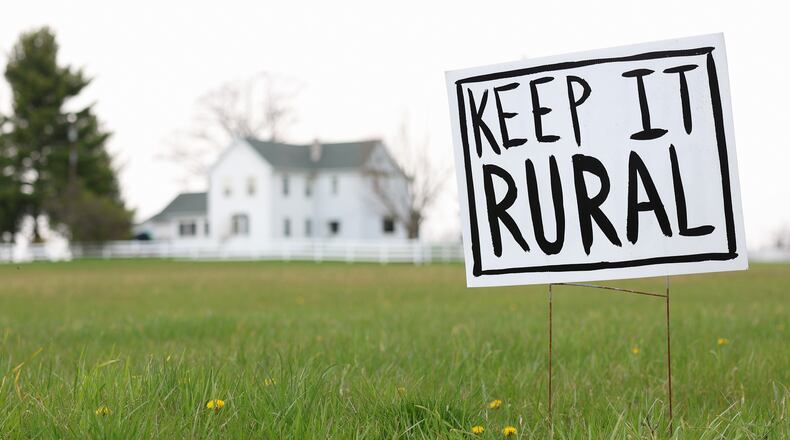Keep It Rural started in Clayton and has grown to involve Brookville, Union, and surrounding areas. The group has a goal to preserve the cities’ zoning codes and only encourage development that maintains the area’s rural feel.
“We love the nature of it; we have deer, hawks, ducks that come back every year, raccoons, possums, all of it,” said Tammy Blevins of Englewood. “Some of these proposed developments would build houses on sites that are three times the density of my property (she lives on a third of an acre), and with only five-foot easements instead of 10; it’s just too much.”
Keep It Rural filed its most recent referendum petition, aiming to ensure Clayton voters have the final say on a 529-home development proposal. Clayton City Council had approved the subdivision after a tense back-and-forth process.
The Montgomery County Board of Elections confirmed last week the petition garnered 914 valid signatures, hundreds more than the 595 needed to put the referendum on the ballot. Clayton council did vote Thursday to confirm the referendum’s placement for the November election.
Credit: JIM NOELKER
Credit: JIM NOELKER
The referendum focuses on a proposal by SDG Warner Village that would see the construction of a 529-home subdivision on 183 acres of land located on the south side of Sweet Potato Ridge Road, just west of Main Street (Ohio 48).
These plans were approved in February by a close vote of Clayton council, an outcome that surprised many residents, as the proposal had previously been rejected the month prior before Clayton Councilwoman Tina Kelly made a motion to reconsider.
The citizen petition comes just over a year after a similar effort by Keep It Rural allowed Clayton voters the final say on a development proposal by Arbor Homes to construct 125 houses at the southeast corner of Phillipsburg-Union Road and Haber Road. Those plans were soundly rejected by voters.
Officials in the housing industry cite a need for more new homes, saying a low supply of up-to-date options is one of the reasons housing prices have spiked.
And while some residents are staunchly against development of any kind, others say they just want it “done right.”
Residents speak up
Tammy Blevins lives in Englewood, but she helped collect signatures of Clayton voters for the Warner Village project referendum. The proposed subdivision would go on what is currently farm field in Clayton, but would run right up to the borders of Union to the north and Englewood to the south.
“This is a community effort and people from all over the area volunteer to help out,” Blevins said about Keep It Rural. “This development in particular would affect everyone in the Northmont school district, so things like traffic, the potential overcrowding of schools, and taxes are things we’re all concerned about.”
Many residents in this northern Montgomery County region purchased homes there for the same reason — they don’t want dense, new development, Blevins said.
Credit: Bryant Billing
Credit: Bryant Billing
Brookville resident Jared Ledford is a member of Moving Brookville Forward, an organization that supports economic and housing development within the city.
Moving Brookville Forward most recently fought an unsuccessful effort by Brookville Citizens for Keep It Rural to remove the city’s mayor and vice mayor in a special election.
Members of Brookville Citizens for Keep It Rural felt resident concerns about increased development in the city had gone ignored, while Moving Brookville Forward members asserted the leaders were doing what they could to appease those concerns while continuing to grow the city sustainably.
While Keep It Rural advocates for more strict development standards, Moving Brookville Forward supports “responsible growth,” Ledford said.
“We don’t necessarily want to see a lot of development, but I think we would like to see the opportunity for the right type of development; whether that be housing, business, or whatever,” he said.
Ledford said he supports any resident-led referendum effort and though he welcomes new home construction and new neighbors, he also supports differences in opinion.
“It’s always good to hear from the people, and if the community has spoken and said they don’t want development at a certain location, then maybe we shouldn’t have development there,” he said.
But Ledford also feels growth is integral to a healthy community with sought-after amenities.
“You can’t have it both ways; you can’t say I don’t want new neighbors, but I want an Outback Steakhouse,” he said. “You’re going to have to take some positive with some negative.”
Local developers weigh in
Lance Oakes is the owner of Oakes Tree Development and has led housing projects across the Dayton region, including Evergreen Trace in Brookville, Copper Mill in Springboro, and Glendean Pointe in Xenia, among others.
Oakes considers several factors when choosing sites for development.
“Number one for me, I follow jobs, then I look for a municipality that actually wants to work with me, and then I’m looking for areas where there is sanitary sewer available,” Oakes said.
Credit: Bryant Billing
Credit: Bryant Billing
Places like Brookville are currently at the center of discussions about new housing, as the city expects to bring in around 700 new jobs with the expansion of General Motors’ DMAX plant.
On the other hand, Brookville has put a temporary moratorium on annexation of land from surrounding townships and cities, a move that Oakes opines could deter developers and future growth.
School districts used to be a significant qualifier of the ideal place to build, he noted, but this has taken a back seat more recently to that of costs.
“If you’re looking at a higher price point and not so concerned about affordability, then schools are still number one,” he said. “But if you’re more concerned with finding a new home today for under the high $200,000s, or lower $300,000s, that will play a bigger role in the decision.”
Demographics also come into play. One feature offered by developers in areas with an aging population is accessory dwelling units, or “in-law suites,” which are additional living spaces on a home’s property that are separate from the main house.
But those units require a higher density building plan, a factor which often contributes to the disapproval of groups like Keep It Rural that, true to the name, want to keep things bucolic.
“Because of that dreaded D-word, density, these lifestyle products are avoided at all costs,” Oakes said. “But, it would increase tax revenue through higher property values without adding more students to the local schools.”
Jeff Kelchner, owner of Clearcreek Custom Builders, urged the public to “keep perspective” when it comes to development.
“Some people may have a different opinion if they saw what would happen if all development stopped over the next 15 years; this would affect a community’s services, tax rates, infrastructure, and amenities,” Kelchner said. “Everyone wants to have that pretty rural setting and a view of farmland around their homes, but it’s also important to look at the big picture.”
Credit: JIM NOELKER
Credit: JIM NOELKER
Finding a middle ground
City leaders are tasked with responding to resident concerns about potential pitfalls of development and expansion while acknowledging the needs of a municipality.
When considering new housing proposals, Brookville City Manager Jack Kuntz said factors like a need for diverse housing options due to aging populations, declining family sizes, and maintaining a healthy workforce are top of mind.
Municipalities can control the type of development that comes to town only to an extent.
“If the city owns the land where a developer desires to build, they have a lot of flexibility on the request. If the city doesn’t own the land, the only controls they have are through the local zoning and other types of regulations,“ Kuntz said.
Residents in these rural areas seem to have found a spot at the negotiation table through a growing strength in numbers, signified by Keep It Rural yard signs popping up throughout cities like Brookville, Union, and Clayton.
Credit: Bryant Billing
Credit: Bryant Billing
It’s also not uncommon for developers to alter plans after first introducing them in a community, an effort to appease some of the residents’ most vocal concerns.
As officials in Brookville work to create an updated comprehensive land use plan, which will dictate future development, residents are encouraged to participate in the process.
“No two residents have the exact (same) set of beliefs, and we continue and welcome civil discussions on the best path forward for our city,” said Brookville City Manager Jack Kuntz.
But development of new housing can be a critical tool for cities, Kuntz maintains, as this growth helps provide and retain resources for a community through increased tax revenue.
“Communities can invest those dollars back into (things like) new infrastructure projects, hiring of new police and fire officers and make capital improvements,” he said. “... Without development, a community’s revenue will not increase and therefore, needed infrastructure and life safety services investment becomes much more difficult.”
About the Author






